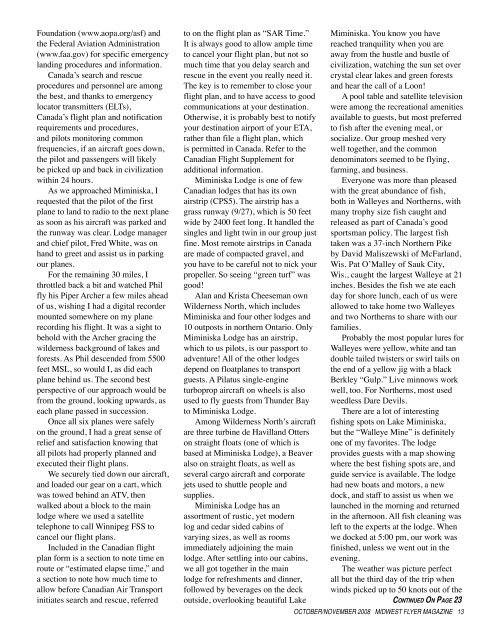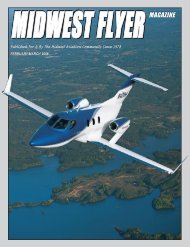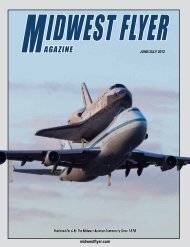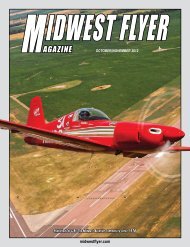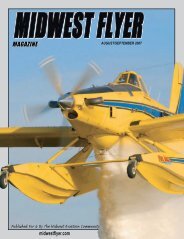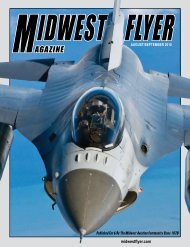Midwest Flyer Magazine
Midwest Flyer Magazine
Midwest Flyer Magazine
Create successful ePaper yourself
Turn your PDF publications into a flip-book with our unique Google optimized e-Paper software.
Foundation (www.aopa.org/asf) and<br />
the Federal Aviation Administration<br />
(www.faa.gov) for specific emergency<br />
landing procedures and information.<br />
Canada’s search and rescue<br />
procedures and personnel are among<br />
the best, and thanks to emergency<br />
locator transmitters (ELTs),<br />
Canada’s flight plan and notification<br />
requirements and procedures,<br />
and pilots monitoring common<br />
frequencies, if an aircraft goes down,<br />
the pilot and passengers will likely<br />
be picked up and back in civilization<br />
within 24 hours.<br />
As we approached Miminiska, I<br />
requested that the pilot of the first<br />
plane to land to radio to the next plane<br />
as soon as his aircraft was parked and<br />
the runway was clear. Lodge manager<br />
and chief pilot, Fred White, was on<br />
hand to greet and assist us in parking<br />
our planes.<br />
For the remaining 30 miles, I<br />
throttled back a bit and watched Phil<br />
fly his Piper Archer a few miles ahead<br />
of us, wishing I had a digital recorder<br />
mounted somewhere on my plane<br />
recording his flight. It was a sight to<br />
behold with the Archer gracing the<br />
wilderness background of lakes and<br />
forests. As Phil descended from 5500<br />
feet MSL, so would I, as did each<br />
plane behind us. The second best<br />
perspective of our approach would be<br />
from the ground, looking upwards, as<br />
each plane passed in succession.<br />
Once all six planes were safely<br />
on the ground, I had a great sense of<br />
relief and satisfaction knowing that<br />
all pilots had properly planned and<br />
executed their flight plans.<br />
We securely tied down our aircraft,<br />
and loaded our gear on a cart, which<br />
was towed behind an ATV, then<br />
walked about a block to the main<br />
lodge where we used a satellite<br />
telephone to call Winnipeg FSS to<br />
cancel our flight plans.<br />
Included in the Canadian flight<br />
plan form is a section to note time en<br />
route or “estimated elapse time,” and<br />
a section to note how much time to<br />
allow before Canadian Air Transport<br />
initiates search and rescue, referred<br />
to on the flight plan as “SAR Time.”<br />
It is always good to allow ample time<br />
to cancel your flight plan, but not so<br />
much time that you delay search and<br />
rescue in the event you really need it.<br />
The key is to remember to close your<br />
flight plan, and to have access to good<br />
communications at your destination.<br />
Otherwise, it is probably best to notify<br />
your destination airport of your ETA,<br />
rather than file a flight plan, which<br />
is permitted in Canada. Refer to the<br />
Canadian Flight Supplement for<br />
additional information.<br />
Miminiska Lodge is one of few<br />
Canadian lodges that has its own<br />
airstrip (CPS5). The airstrip has a<br />
grass runway (9/27), which is 50 feet<br />
wide by 2400 feet long. It handled the<br />
singles and light twin in our group just<br />
fine. Most remote airstrips in Canada<br />
are made of compacted gravel, and<br />
you have to be careful not to nick your<br />
propeller. So seeing “green turf” was<br />
good!<br />
Alan and Krista Cheeseman own<br />
Wilderness North, which includes<br />
Miminiska and four other lodges and<br />
10 outposts in northern Ontario. Only<br />
Miminiska Lodge has an airstrip,<br />
which to us pilots, is our passport to<br />
adventure! All of the other lodges<br />
depend on floatplanes to transport<br />
guests. A Pilatus single-engine<br />
turboprop aircraft on wheels is also<br />
used to fly guests from Thunder Bay<br />
to Miminiska Lodge.<br />
Among Wilderness North’s aircraft<br />
are three turbine de Havilland Otters<br />
on straight floats (one of which is<br />
based at Miminiska Lodge), a Beaver<br />
also on straight floats, as well as<br />
several cargo aircraft and corporate<br />
jets used to shuttle people and<br />
supplies.<br />
Miminiska Lodge has an<br />
assortment of rustic, yet modern<br />
log and cedar sided cabins of<br />
varying sizes, as well as rooms<br />
immediately adjoining the main<br />
lodge. After settling into our cabins,<br />
we all got together in the main<br />
lodge for refreshments and dinner,<br />
followed by beverages on the deck<br />
outside, overlooking beautiful Lake<br />
Miminiska. You know you have<br />
reached tranquility when you are<br />
away from the hustle and bustle of<br />
civilization, watching the sun set over<br />
crystal clear lakes and green forests<br />
and hear the call of a Loon!<br />
A pool table and satellite television<br />
were among the recreational amenities<br />
available to guests, but most preferred<br />
to fish after the evening meal, or<br />
socialize. Our group meshed very<br />
well together, and the common<br />
denominators seemed to be flying,<br />
farming, and business.<br />
Everyone was more than pleased<br />
with the great abundance of fish,<br />
both in Walleyes and Northerns, with<br />
many trophy size fish caught and<br />
released as part of Canada’s good<br />
sportsman policy. The largest fish<br />
taken was a 37-inch Northern Pike<br />
by David Maliszewski of McFarland,<br />
Wis. Pat O’Malley of Sauk City,<br />
Wis., caught the largest Walleye at 21<br />
inches. Besides the fish we ate each<br />
day for shore lunch, each of us were<br />
allowed to take home two Walleyes<br />
and two Northerns to share with our<br />
families.<br />
Probably the most popular lures for<br />
Walleyes were yellow, white and tan<br />
double tailed twisters or swirl tails on<br />
the end of a yellow jig with a black<br />
Berkley “Gulp.” Live minnows work<br />
well, too. For Northerns, most used<br />
weedless Dare Devils.<br />
There are a lot of interesting<br />
fishing spots on Lake Miminiska,<br />
but the “Walleye Mine” is definitely<br />
one of my favorites. The lodge<br />
provides guests with a map showing<br />
where the best fishing spots are, and<br />
guide service is available. The lodge<br />
had new boats and motors, a new<br />
dock, and staff to assist us when we<br />
launched in the morning and returned<br />
in the afternoon. All fish cleaning was<br />
left to the experts at the lodge. When<br />
we docked at 5:00 pm, our work was<br />
finished, unless we went out in the<br />
evening.<br />
The weather was picture perfect<br />
all but the third day of the trip when<br />
winds picked up to 50 knots out of the<br />
Co n t i n u e d On Pa g e 23<br />
OCTOBER/NOVEMBER 2008 MIDWEST FLYER MAGAZINE 13


